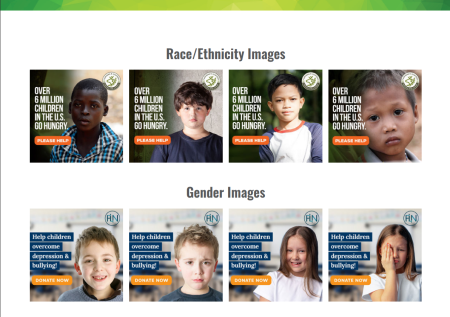Is there 'bias' among Evangelicals when it comes to fundraising ads?

Are Evangelicals more likely to view advertisements for charities supporting struggling children favorably if the child depicted in the advertisement is the same race they are? That is among the questions that a new 22-page study explores.
The study "Race and Gender in Fundraising" by Infinity Concepts and Grey Matter Research seeks to "explore potential bias" among Evangelicals regarding their perception of fundraising advertisements.
Conducted online in early 2023 among 1,010 Evangelical Protestants — a group representing an estimated 59 million American adults — the researchers used "stringent quality control … to eliminate any responses from bots, click farms, and disengaged or fraudulent respondents." Researchers also screened for a demographically representative sample for Evangelical beliefs and lack of non-Protestant affiliation.
The poll used two sets of advertising images formatted similarly to banner ads, consisting primarily of an image of a child without much additional information.
One set of banner ads states, "Over 6 million children in the U.S. go hungry. Please Help." Each image contains a picture of a child of a different ethnicity: white, black, Latino and Asian. Researchers say they tried as much as possible to keep all four images very similar, with only one difference among them.
Another set of banner ads reads, "Help children overcome depression & bullying. Donate Now." Two of the banner ads in this set include photos of boys and the other two include photos of girls.

Most significantly, the study did not find any "statistically significant or meaningful" differences between how Evangelicals view an ad with a child of their own race versus a child of a different race, with average ratings on the study's scale falling "well within the margin of error for the survey," according to researchers.
When seeing an ad featuring a child of the same race as the respondent, 38% of Evangelicals said they found the ad "extremely compelling." When seeing a child of a different race from their own, 36% of Evangelicals said they find the ad extremely compelling.
When it comes to the biological sex of the child depicted in the ads, men were more likely to say the ad is extremely compelling upon seeing an image of a boy compared with ads featuring a girl (32% to 27%).
While women were more likely to view ads with the boy as extremely compelling than the ads with girls (39% to 25%), the study found women were also more likely to say the ads with boys are "touching," "urgent" and "are the kind of person they want to help."
"On the subject of gender, it does appear there is some bias toward helping boys over girls, and interestingly, that bias is substantially stronger among female Evangelicals," researchers said.
"We would need considerable further testing to know whether this bias would exist with images of different age groups, races, types of organizations, etc. But the bias is present in this test."
Researchers say they found among potential Evangelical donors, black Evangelicals believe the ads are "substantially more compelling" than other Evangelicals, regardless of the race or ethnicity of the child pictured.
Over half (52%) of black Evangelicals said they found the ads extremely compelling compared to just over a third (34%) of all other Evangelicals.
Black Evangelicals were also less likely than others to describe the ads as "discouraging or easy to ignore" and more likely to find them hopeful, realistic, believable and relatable, according to the study.
Researchers say they also found statistically significant differences in the language used by Evangelicals to describe the ads: the ads featuring either a Latino or white child were more likely to be considered "easy to ignore" compared with those of a black or Asian child.
According to the study, the ad with the Latino child was less likely to be described as "gets my attention" than any of the other ads, while the ad with the white child was somewhat more likely to be called "urgent" than the ad with the Latino child.
A total of 60% of respondents gave the ad with the Latino child a positive rating, compared to 72% for the black child, 75% for the white child and 78% for the Asian child.
However, researchers believe the discrepancy between the rating for the ad with the Latino child and the other ads is due to "something about the picture, other than the child's ethnicity," since that image features "several small but significant differences."





















